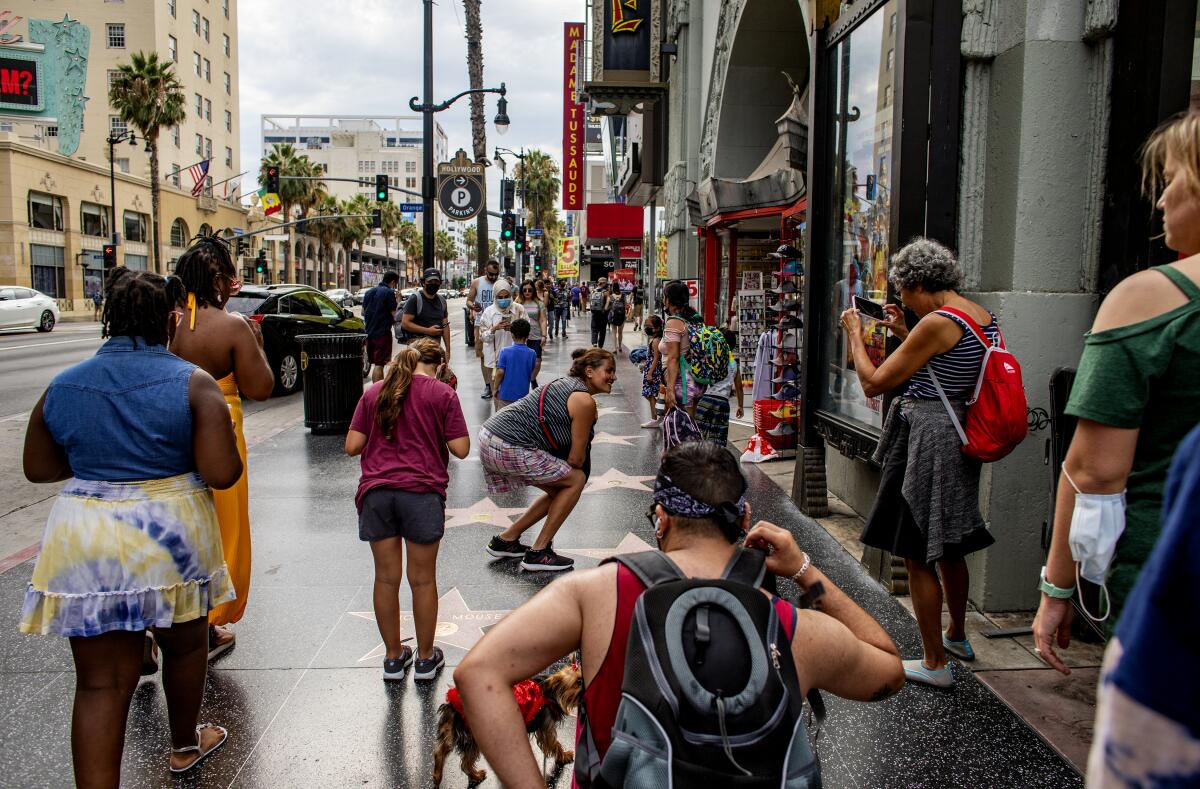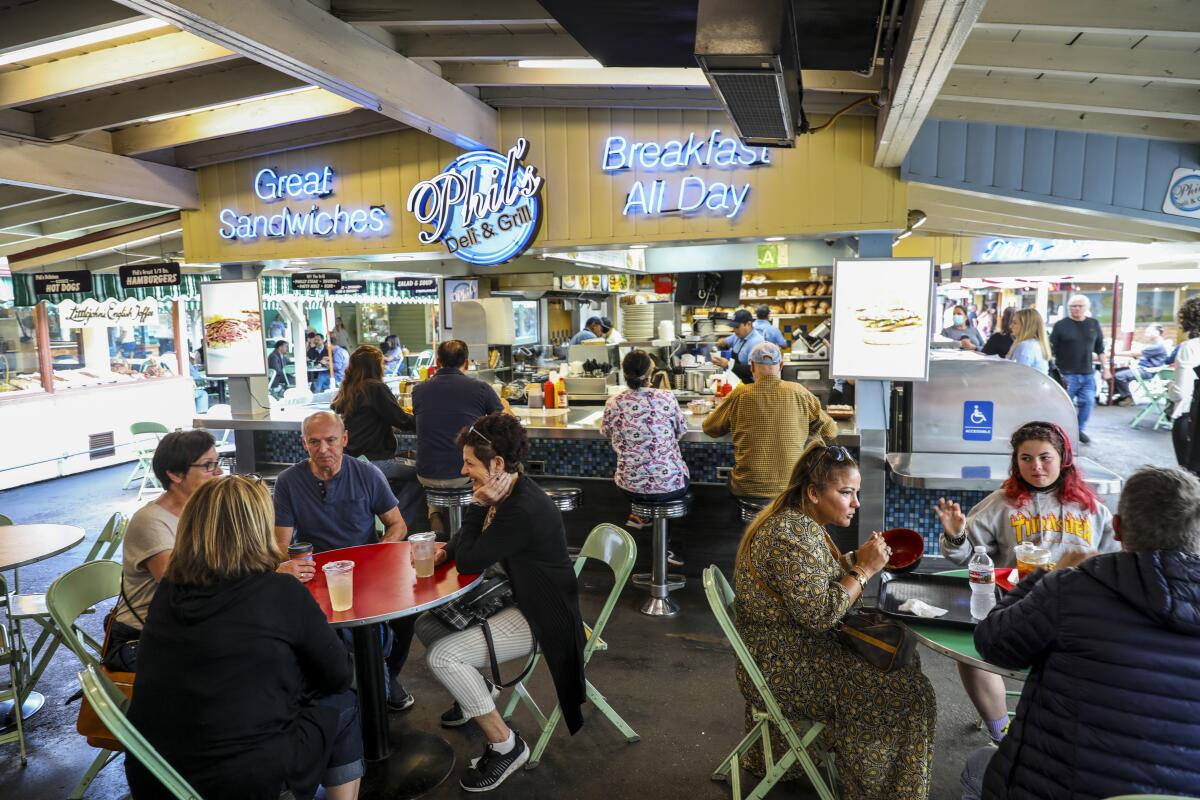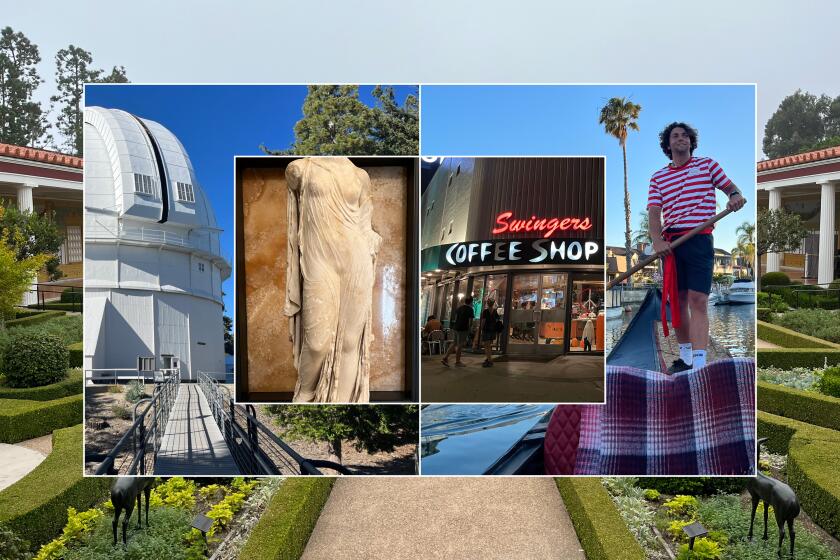A slice of tourists hasn’t returned since COVID. L.A. wants them back.

Before the pandemic, a steady stream of buses ferrying tourists from Brazil, China, Australia and elsewhere pulled into the Original Farmers Market every day. They typically idled for an hour or so, while their passengers ate and shopped for souvenirs at the historic collection of food stalls and kitschy shops in the heart of Los Angeles.
The buses still come these days. But, if the city’s overall tourism figures are any indication, the number of international travelers isn’t what it used to be.
Adam Burke is looking to fix that.
As president and chief executive of the Los Angeles Tourism and Convention Board, Burke has watched the city rebound after the dark days of COVID-19 to reassert itself as one of the country’s most popular travel destinations. The recovery, however, is incomplete as visits from international travelers remain well below pre-pandemic levels.
Boosting those visits, Burke said, is crucial to the overall strength of L.A.’s tourism industry, which brought in nearly $22 billion in 2022 and has more than 530,000 people working in tourism-related careers, according to city statistics. Foreign travelers tend to stay longer and spend more.
“It’s impossible to overstate how critically important international visitation is to L.A.,” Burke said, adding that the spending power of one international traveler is equal to three domestic visitors.
A pit stop at the farmers market is one of the many offerings that local officials, hotel executives and others from the L.A. tourism industry will be pitching to representatives from hundreds of international travel-related companies during an annual conference at L.A.’s convention center this week.
They’re hoping the conference provides an additional boost to the number of visits from abroad. While the volume of domestic visitors to L.A. has recovered to pre-pandemic levels, the 5.8 million international visitors L.A. received last year represents only about three-quarters of the total who came in 2019, according to figures from the tourism board.
Los Angeles is massive. When visiting — or hosting tourists — use this bucket list of activities to see a range of landmarks, museums, shops and local eccentricities.
The conference marks the start of a broader campaign by the tourism board, which plans to use money from a federal grant to bolster marketing and branding targeting international travelers.
The push to regain foreign visitors in L.A. is reflected in national tourism statistics. Before the pandemic hit, the amount that visitors to the U.S. spent in the country outpaced the total that American travelers spent abroad, giving the country a so-called travel trade surplus. Beginning in the summer of 2021, however, that balance has shifted as international travel to the U.S. has slipped, according to the U.S. International Trade Administration.
In California, as elsewhere, the slowdown in international tourism has been driven largely by the flagging number of visitors from China and other Asian countries, industry experts said.
Although the more than 75 million departures and arrivals at Los Angeles International Airport in 2023 marked a nearly 14% jump in volume from the previous year, the total was still about 15% below the airport’s traffic in 2019, said Dae Levine, a spokesperson for Los Angeles World Airports.
“The gap we are looking to make up is flights to and from China,” Levine said.
Chilly relations between the U.S. and China, as well as restrictions to Russian airspace that interfere with flight routes, have meant that the number of flights arriving from China has remained low despite the end of the lockdown.

The number of flights has been climbing gradually over the last year. Since the end of March, U.S. transportation officials have allowed Chinese airlines to increase the number of round-trip flights into the country each week from 35 to 50, which is nearly a third of pre-pandemic levels.
Tourism officials in L.A. are encouraged by the upcoming conference, for which
China is expected to send one of the largest delegations .
The slow pace of processing visa applications has further dissuaded travelers, said Geoff Freeman, president of the U.S. Travel Assn. In India, would-be tourists typically must wait more than a year for an interview at the U.S. Embassy or a consulate that is a part of the visa application, and in Colombia the wait can stretch to nearly two years, he said.
“As you can imagine, if someone told you there was a 700-day wait, you would say, ‘I’m going to go somewhere else,’” Freeman said.
Burke, who serves as a member of the U.S. Department of Commerce’s Travel and Tourism Advisory Board, is among those pushing the White House to ease travel restrictions, address visa backlogs and boost flight volumes.
In some ways, L.A. as a tourist destination is a difficult sell, said Jan Brueckner, an economics professor at UC Irvine.
“L.A. is not such a great city for getting around,” Brueckner said. “In L.A., to get around you really need a rental car and that’s a factor that makes things more expensive, and people may encounter our famous traffic congestion, which is not pleasant.”
While there’s nothing inherently wrong with taking visitors to the Hollywood Walk of Fame, there are plenty of ways to enjoy local wonders with thinner crowds and better parking.
And although major events scheduled to be held in L.A. in the next few years — including the World Cup in 2026 and the Summer Olympics in 2028 — will draw huge numbers of visitors from abroad, they are not without their complications and risks.
For example, efforts to resolve long-running labor disputes at dozens of L.A.-area hotels have made progress in recent months, but new contracts signed by workers are set to expire in early 2028, leaving open the possibility of labor unrest at hotels just before the Olympics.
Old hands in the tourism trade are used to that kind of uncertainty.
“You have to be prepared for anything. We could have earthquakes, riots and unrest,” said Scott Bennett, owner of Bennett’s Ice Cream, a mainstay at the Farmers Market for more than 60 years.
He recalled how during the COVID-19 lockdowns, tables and chairs were removed from the market’s patio and he had to let the shop’s 12 employees go. Instead of serving cones to customers, the store survived by Bennett selling hand-scooped pints for takeout.
Now, staffing is back, as are sales, said Bennett, who is looking forward to a hot summer. “When it’s hot, people want ice cream.”
Burke of the tourism board, meanwhile, is hoping that Bennett will hear a few more foreign languages being spoken among customers waiting in line.
“They are the golden goose of the industry,” he said of foreign tourists.
More to Read
Inside the business of entertainment
The Wide Shot brings you news, analysis and insights on everything from streaming wars to production — and what it all means for the future.
You may occasionally receive promotional content from the Los Angeles Times.













